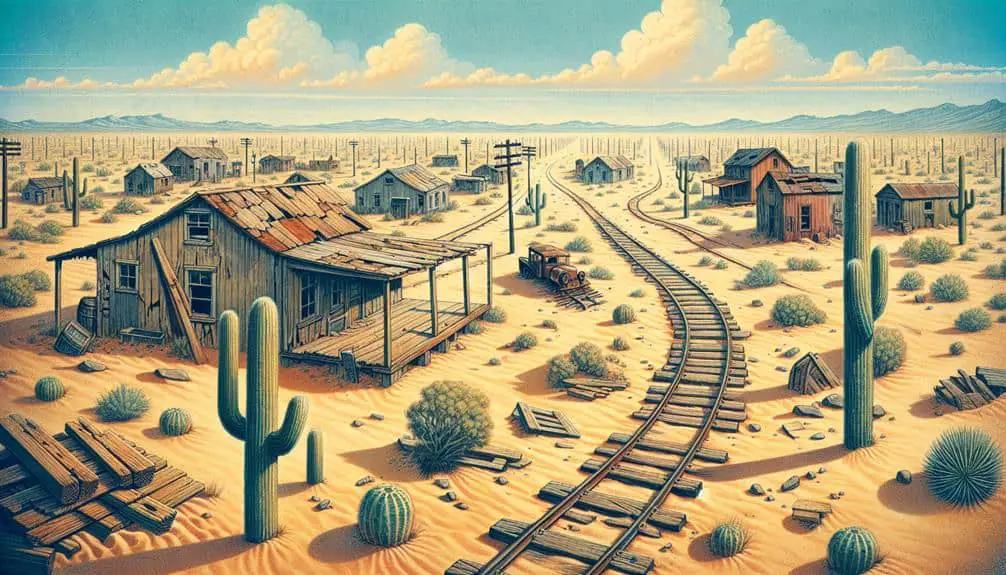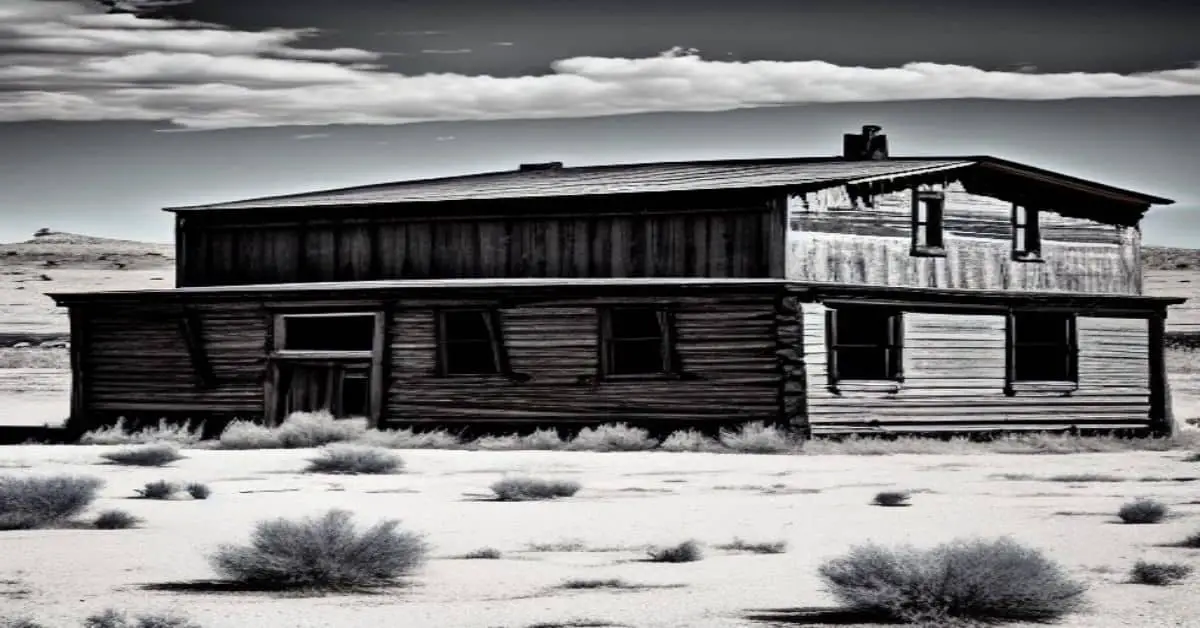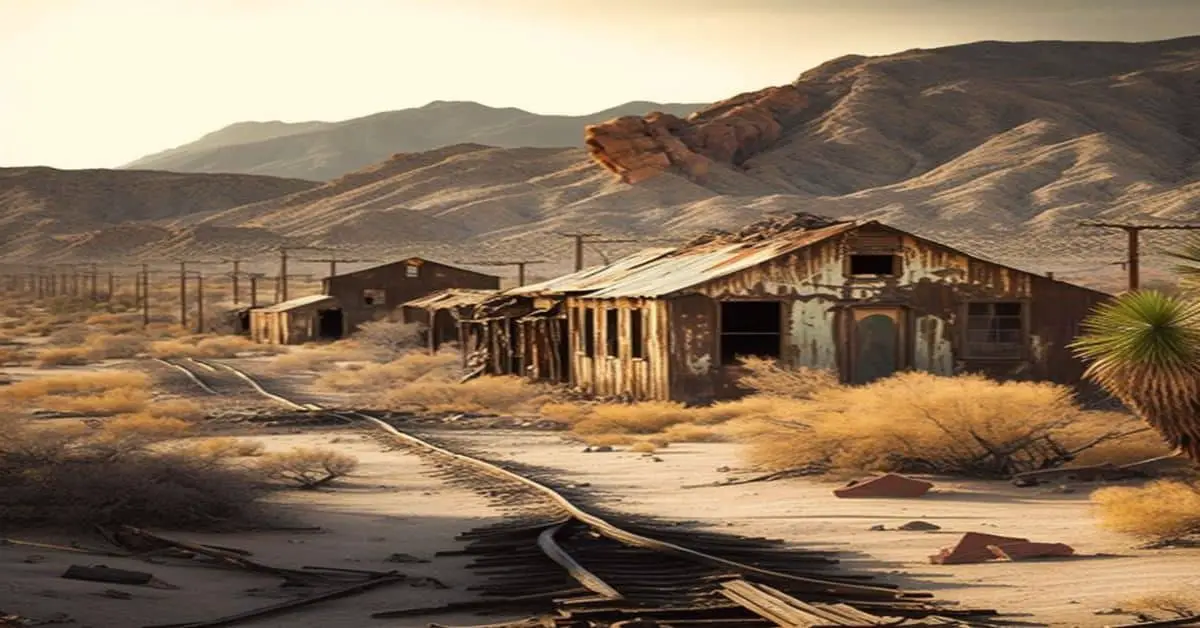When the railroad worker settlements in Arizona became deserted, it was a result of a combination of factors. Economic shifts, technological advancements, and environmental challenges all played a role. As rail technology advanced and other industries thrived, the demand for railroad labor decreased. Harsh working conditions, low wages, and labor strikes added to tensions, leading workers to abandon settlements. Water scarcity and climate change impacted these communities, accelerating their decline. If you want to uncover more about the transformation of these settlements from bustling hubs to ghost towns, explore the deeper layers of history and change that affected their fate.
Key Points
- Harsh working conditions and low wages led to labor strikes and worker desertion.
- Economic changes from rail technology advancements displaced jobs, causing settlement decline.
- Environmental challenges like water scarcity and climate change impacted deserted settlements.
- Competition from highways and air travel, and technological advancements, led to railroad industry decline.
- Abandonment of settlements resulted from decreased rail demand, leading to ghost town status.
Historical Background of Railroad Worker Settlements
During the late 19th and early 20th centuries, numerous railroad worker settlements sprang up across Arizona, reflecting the rapid expansion of the railway network in the region. The industrial revolution played a significant role in the establishment of these settlements, as the demand for labor to build and maintain the railways surged.
These settlements were often situated near railway lines, providing housing and amenities for workers and their families. However, the significance of these settlements was often marred by labor strikes. Workers, facing harsh working conditions and demanding long hours, frequently organized strikes to protest against low wages and poor treatment by railway companies.
These labor strikes not only disrupted the operations of the railways but also had a lasting impact on the relationships between workers and management. The tensions arising from these strikes sometimes led to the desertion of these settlements as workers sought better opportunities elsewhere, marking an important chapter in the history of Arizona's railroad worker communities.
Impact of Economic Changes
Amidst shifting economic landscapes, the deserted railroad worker settlements in Arizona underwent profound transformations, reflecting the intricate interplay between industrial progress and socioeconomic challenges. The impact of economic changes was pivotal in the decline of these settlements. Job displacement due to advancements in rail technology and changes in transportation routes played a significant role in the dwindling population of these once-thriving communities. As workers lost their jobs or were forced to relocate for employment opportunities elsewhere, the tight-knit fabric of these settlements began to unravel, leading to community disintegration.
The economic shifts not only affected individuals but also had a ripple effect on the overall social cohesion of the settlements. With the loss of stable employment and the subsequent exodus of residents, businesses struggled to stay afloat, further exacerbating the economic downturn. As the economic foundations crumbled, the once-vibrant railroad worker settlements in Arizona succumbed to the harsh realities of job displacement and community disintegration.
Environmental Challenges Faced
The economic changes that led to the decline of railroad worker settlements in Arizona also set the stage for the environmental challenges faced by these abandoned communities. As these settlements were left deserted, issues of water scarcity and the impacts of climate change became more pronounced. With limited access to water sources in the arid Arizona landscape, the deserted settlements struggled to sustain themselves. Climate change further exacerbated these challenges, leading to more frequent and severe droughts in the region. The lack of human intervention and maintenance in these areas also allowed for environmental degradation to occur more rapidly.
Water scarcity became a pressing concern as the once-thriving settlements now sat empty, unable to support life without a consistent water supply. Climate change added another layer of complexity to the situation, altering weather patterns and making the arid conditions even more challenging to navigate. These environmental challenges highlight the delicate balance between human activity, sustainability, and the natural world.
Decline of Railroad Industry in Arizona
As economic shifts unfolded, the railroad industry in Arizona experienced a notable decline. This decline was marked by an economic downturn that profoundly impacted the industry's operations and workforce. Here are four key factors contributing to the decline:
- Increased Competition: The rise of alternative transportation modes, such as highways and air travel, led to a decrease in demand for rail services, affecting the industry's profitability.
- Technological Advancements: The advent of more efficient transportation technologies reduced the relative advantages of railroads, making them less attractive for both passengers and freight transportation.
- Changing Economic Landscape: Shifting consumer preferences and economic priorities favored other industries over railroads, leading to a decrease in investments and overall support for the sector.
- Workforce Migration: As the industry faced challenges, many railroad workers sought employment opportunities in other regions or sectors, causing a substantial migration of skilled labor away from Arizona's railroad industry.
These factors combined to create a perfect storm that contributed to the decline of the railroad industry in Arizona, ultimately leading to the deserted railroad worker settlements we see today.
Abandonment and Current Status
With the decline of the railroad industry in Arizona, the abandonment and current status of railroad worker settlements reflect the lasting impact of economic shifts on these once-thriving communities. The reasons behind the desertion of these settlements are multifaceted. As the demand for rail transportation decreased and industries shifted focus, many workers left these settlements in search of new employment opportunities. The lack of maintenance and investment in infrastructure also contributed to the decline, making these areas less appealing for residents.
Currently, many of these deserted railroad worker settlements stand as ghost towns, with dilapidated buildings and a sense of abandonment lingering in the air. However, there are revival opportunities on the horizon. Some communities are exploring ways to repurpose these historic sites, turning them into tourist attractions or cultural centers. By leveraging the unique history and architecture of these settlements, there's potential to breathe new life into these once-vibrant communities. It remains to be seen whether these revival efforts will be successful in restoring these areas to their former glory.
Frequently Asked Questions
What Role Did the Local Indigenous Communities Play in the Development and Eventual Abandonment of the Railroad Worker Settlements in Arizona?
In the development and abandonment of railroad worker settlements in Arizona, Indigenous involvement and cultural dynamics played significant roles. Understanding their impact on these communities sheds light on the complexities of historical interactions and societal changes.
How Did the Healthcare and Education Systems in These Settlements Contribute to Their Decline and Desertion?
When healthcare access dwindles and educational quality falters in settlements, decline looms. Desertion follows as basic needs unmet breed discontent. Neglecting these pillars erodes the foundation, leading to the downfall of communities.
Were There Any Instances of Conflict or Tension Between Different Ethnic Groups Living in These Settlements That May Have Influenced Their Abandonment?
Ethnic tensions and cultural interactions among diverse groups in settlements could have influenced their abandonment. Understanding historical conflicts is essential for grasping how differences impacted the dynamic of these communities and led to desertion.
What Efforts, if Any, Have Been Made to Preserve or Repurpose the Remaining Structures in the Deserted Railroad Worker Settlements in Arizona?
Interested in preserving history? Historic preservation efforts in Arizona's deserted railroad worker settlements aim to honor the past. Through adaptive reuse, some structures find new life, blending modernity with heritage for future generations to cherish.
How Did the Emergence of New Transportation Technologies, Such as Automobiles and Airplanes, Impact the Desertion of These Settlements?
The emergence of new transportation technologies like automobiles and airplanes had a significant impact on the desertion of settlements. As development progressed, innovation in travel made these areas less essential, leading to abandonment.



